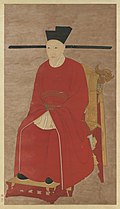1127
Lua error in package.lua at line 80: module 'Module:Ancient Olympiads' not found.
| Millennium: | 2nd millennium |
|---|---|
| Centuries: | 11th century – 12th century – 13th century |
| Decades: | 1090s 1100s 1110s – 1120s – 1130s 1140s 1150s |
| Years: | 1124 1125 1126 – 1127 – 1128 1129 1130 |
| 1127 by topic |
|---|
| Arts, history, and science |
| Countries |
|
|
| Lists of leaders |
| Birth and death categories |
| Establishments and disestablishments categories |
| Works category |
| Wikimedia Commons has media related to Lua error in Module:Commons_link at line 62: attempt to index field 'wikibase' (a nil value).. |
1127 (MCXXVII) was a common year starting on Saturday of the Julian calendar, the 1127th year of the Common Era (CE) and Anno Domini (AD) designations, the 127th year of the 2nd millennium, the 27th year of the 12th century, and the 8th year of the 1120s decade. As of the start of 1127, the Gregorian calendar was 7 days ahead of the Julian calendar, which was the dominant calendar of the time.

The Kalyan minaret
Events
- Estimation: Constantinople, capital of the Byzantine Empire, becomes the largest city in the world, taking the lead from Kaifeng, capital of China.
By area
Asia
Europe
- Conrad III establishes the Hohenstaufen dynasty when he is crowned antiking to the Holy Roman Emperor, Lothair II.
- The first coalition of the Norman princes against Roger II of Sicily is formed. The same year, Roger regains control over Malta after a rebellion.[1] To guaranty the security of the seas, the king also establishes a pact with the maritime republic of Savona,[2] probably following an Almoravid raid against his realm.[3]
- Count Charles the Good of Flanders is assassinated.
- First mention of the consuls in Brescia, indicating that the city has become an independent commune.
- The commune of Milan conquers the neighboring city of Como.
By topic
Arts
- The minaret of Kalyan is completed in Bukhara (present day Uzbekistan).
Births
- October 18 – Emperor Go-Shirakawa of Japan (d. 1191)
- November 27 – Emperor Xiaozong of China (d. 1194)
- Constance of Antioch (d. 1163), the Princess regnant of the principality of Antioch
- Yang Wanli, Chinese poet (d. 1206)
Deaths
- probable – Fulcher of Chartres, French chronicler (b. c. 1059)
- Gilla Críst Ua Máel Eóin, abbot of Clonmacnoise [4]
1127 Media
Emperor Gaozong of Song (1107–1187) rules from 1127
References
- ↑ Abulafia, David (1985). The Norman kingdom of Africa and the Norman expeditions to Majorca and the Muslim Mediterranean. Woodbridge: Boydell Press. ISBN 0-85115-416-6.
- ↑ Bresc, Henri (2003). "La Sicile et l'espace libyen au Moyen Age" (PDF). Retrieved January 17, 2012.
{{cite journal}}: Cite journal requires|journal=(help) - ↑ Johns, Jeremy (2002). Arabic administration in Norman Sicily: the royal dīwān. Cambridge: Cambridge University Press. p. 85. ISBN 0-521-81692-0.
- ↑ Annals of the Four Masters. Ireland: Corpus of Electronic Texts (UCC), Annal M1127.1. 1127.
